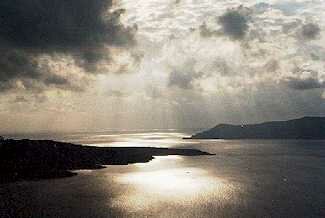Santorini
Any mention of Greece conjures up a myriad of images - deep-blue seas and stunning beaches, olive groves and stony hillsides, ancient cities and white-washed houses. History, landscape, and culture have intertwined in this corner of the western Mediterranean to create a nation with a unique identity - a land straddling the modern and ancient worlds. Santorini, the southernmost island of the Cycladic archipelago, offers a taste of all of these attributes, and is also one of Greece's most popular island destinations.
 |
Looming hundreds of feet above the blue waters of the harbour, the sheer volcanic cliffs of Santorini provide an unforgettable introduction for visitors to this beautiful island. Above the harbour, the brilliant white cliff-top communities speak of islander's determination to co-exist with this landscape shaped by dramatic forces, and written of in legend. The unique combination of red-black volcanic sand beaches, stunning white towns tumbling precariously from the cliff edges, and the archaeological remnants of the long-vanished Minoan civilisation draw an endless stream of visitors for much of the year. Few leave disappointed.
Inhabited for thousands of years, Santorini was an important outpost of the Minoan civilisation. By about 1500 B.C. however, the volcano-island had become dangerously unstable, causing most of the Minoans to abandon their towns. When the volcano eventually erupted, it was one of the most cataclysmic events in history - earthquakes reverberated across the Aegean, ash and debris buried neighbouring islands, and half of the island sank below the sea. The Minoan civilisation was dealt a mortal blow, and the sophisticated communities that had prospered on Santorini for so long were no more.
The ancient site of Akrotiri provides the modern visitor with a tangible link to these historic upheavals, with a succession of excavated structures open to the public. The lavish frescoes and pottery unearthed at Akrotiri provided exquisite evidence of the Minoan way of life, and of a rich artistic culture.
A few miles north of Akrotiri is Fira, the modern capital of Santorini. This picture-postcard town of white houses and winding alleyways is the most popular destination for visitors to the island, and deservedly so. Hanging between the ocean and the sky, Fira's precarious location is a remarkable testament to island ingenuity, and a singular Greek island experience. Fira has expanded in recent years to cater for the tourist trade, but can be very busy in the peak season. There are numerous tavernas and restaurants around the town to meet this demand - a number possessing spectacular cliff-top locations and views to match.
Directly below Fira is the old harbour, the departure point for many of the island's boating excursions, including those to the two volcanic islands in the harbour. Formed by continuing underwater eruptions, both islands can be visited, and at one it's possible to swim in sulphurous hot springs that have formed at the sea edge.
The pristine white houses, blue-domed churches, and stunning vistas of Ia provide a tranquil alternative to Fira. Formerly a prosperous fishing village, tourist development is yet to encroach too noticeably on the life of Ia, although busloads from throughout the island journey here in the evening for the often memorable sunsets.
For those visitors who arrive in search of sand and sun, Santorini can come as a surprise. Long red-black volcanic sand beaches are the norm, and these can get very hot and crowded in summer. There are also a number of more remote beaches for those that want to escape the crowds.
No visit to Santorini would be complete without a journey to the interior, with its sleepy villages and terraced fields. Pyrgos, a small village 8 km south of Fira, was once the island's capital, and the remnants of a large Venetian fortress overlooking the village testifies to its former status. Further inland is the monastery of Profitis Ilias, now ome to just one solitary monk, and commanding fine views over the island.
Santorini - Fact File
Getting There - Island ferries arrive at the small port of Ormos Athinios, 6 km south of Fira. Numerous ferry services operate to and from a number of other islands and Athens. The airport is on the far side of the island, and connected to Fira by a regular shuttle bus service during the day.
Accommodation - With accommodation difficult to find during the peak season, arriving a few weeks either side of mid-summer can make all the difference. From May the sunshine is consistent, with temperatures regularly above 20C, and the climate remains benevolent well into October. Accommodation prices also tumble in these 'shoulder' periods. Hotel touts meet all incoming ferries, and it may be worth checking what's on offer, as they will normally transport you to the hotel themselves free of charge. Prices and availability out of Fira may also be worth investigating.
More Information
Check out Go Greece or (for ferry information) the useful Ferries portal.
Also visit our Greek Island guide.
|





